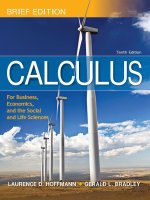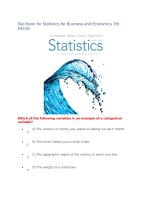Statistics for business economics 7th by paul newbold chapter 02
Bạn đang xem bản rút gọn của tài liệu. Xem và tải ngay bản đầy đủ của tài liệu tại đây (587.73 KB, 56 trang )
Statistics for
Business and Economics
7th Edition
Chapter 2
Describing Data: Numerical
Copyright © 2010 Pearson Education, Inc. Publishing as Prentice Hall
Ch. 2-1
Chapter Goals
After completing this chapter, you should be able to:
Compute and interpret the mean, median, and mode for a
set of data
Find the range, variance, standard deviation, and
coefficient of variation and know what these values mean
Apply the empirical rule to describe the variation of
population values around the mean
Explain the weighted mean and when to use it
Explain how a least squares regression line estimates a
linear relationship between two variables
Copyright © 2010 Pearson Education, Inc. Publishing as Prentice Hall
Ch. 2-2
Chapter Topics
Measures of central tendency, variation, and
shape
Mean, median, mode, geometric mean
Quartiles
Range, interquartile range, variance and standard
deviation, coefficient of variation
Symmetric and skewed distributions
Population summary measures
Mean, variance, and standard deviation
The empirical rule and Bienaymé-Chebyshev rule
Copyright © 2010 Pearson Education, Inc. Publishing as Prentice Hall
Ch. 2-3
Chapter Topics
(continued)
Five number summary and box-and-whisker
plots
Covariance and coefficient of correlation
Pitfalls in numerical descriptive measures and
ethical considerations
Copyright © 2010 Pearson Education, Inc. Publishing as Prentice Hall
Ch. 2-4
Describing Data Numerically
Describing Data Numerically
Central Tendency
Variation
Arithmetic Mean
Range
Median
Interquartile Range
Mode
Variance
Standard Deviation
Coefficient of Variation
Copyright © 2010 Pearson Education, Inc. Publishing as Prentice Hall
Ch. 2-5
2.1
Measures of Central Tendency
Overview
Central Tendency
Mean
Median
Mode
Midpoint of
ranked values
Most frequently
observed value
n
x
i
x i1
n
Arithmetic
average
Copyright © 2010 Pearson Education, Inc. Publishing as Prentice Hall
Ch. 2-6
Arithmetic Mean
The arithmetic mean (mean) is the most
common measure of central tendency
For a population of N values:
N
x
i
x1 x 2 x N
μ
N
N
i1
Population
values
Population size
For a samplen of size n:
x
x
i1
n
i
x1 x 2 x n
n
Copyright © 2010 Pearson Education, Inc. Publishing as Prentice Hall
Observed
values
Sample size
Ch. 2-7
Arithmetic Mean
(continued)
The most common measure of central tendency
Mean = sum of values divided by the number of values
Affected by extreme values (outliers)
0 1 2 3 4 5 6 7 8 9 10
Mean = 3
1 2 3 4 5 15
3
5
5
Copyright © 2010 Pearson Education, Inc. Publishing as Prentice Hall
0 1 2 3 4 5 6 7 8 9 10
Mean = 4
1 2 3 4 10 20
4
5
5
Ch. 2-8
Median
In an ordered list, the median is the “middle”
number (50% above, 50% below)
0 1 2 3 4 5 6 7 8 9 10
0 1 2 3 4 5 6 7 8 9 10
Median = 3
Median = 3
Not affected by extreme values
Copyright © 2010 Pearson Education, Inc. Publishing as Prentice Hall
Ch. 2-9
Finding the Median
The location of the median:
n 1
Median position
position in the ordered data
2
If the number of values is odd, the median is the middle number
If the number of values is even, the median is the average of
the two middle numbers
n 1
Note that 2 is not the value of the median, only the
position of the median in the ranked data
Copyright © 2010 Pearson Education, Inc. Publishing as Prentice Hall
Ch. 2-10
Mode
A measure of central tendency
Value that occurs most often
Not affected by extreme values
Used for either numerical or categorical data
There may may be no mode
There may be several modes
0 1 2 3 4 5 6 7 8 9 10 11 12 13 14
Mode = 9
Copyright © 2010 Pearson Education, Inc. Publishing as Prentice Hall
0 1 2 3 4 5 6
No Mode
Ch. 2-11
Review Example
Five houses on a hill by the beach
$2,000 K
House Prices:
$2,000,000
500,000
300,000
100,000
100,000
$500 K
$300 K
$100 K
$100 K
Copyright © 2010 Pearson Education, Inc. Publishing as Prentice Hall
Ch. 2-12
Review Example:
Summary Statistics
House Prices:
$2,000,000
500,000
300,000
100,000
100,000
Mean:
Median: middle value of ranked data
= $300,000
Mode: most frequent value
= $100,000
Sum 3,000,000
Copyright © 2010 Pearson Education, Inc. Publishing as Prentice Hall
($3,000,000/5)
= $600,000
Ch. 2-13
Which measure of location
is the “best”?
Mean is generally used, unless extreme values
(outliers) exist . . .
Then median is often used, since the median
is not sensitive to extreme values.
Example: Median home prices may be reported for
a region – less sensitive to outliers
Copyright © 2010 Pearson Education, Inc. Publishing as Prentice Hall
Ch. 2-14
Shape of a Distribution
Describes how data are distributed
Measures of shape
Symmetric or skewed
Left-Skewed
Symmetric
Right-Skewed
Mean < Median
Mean = Median
Median < Mean
Copyright © 2010 Pearson Education, Inc. Publishing as Prentice Hall
Ch. 2-15
Geometric Mean
Geometric mean
Used to measure the rate of change of a variable
over time
1/n
x g (x1 x 2 x n ) (x1 x 2 x n )
n
Geometric mean rate of return
Measures the status of an investment over time
rg (x1 x 2 ... x n )1/n 1
Where xi is the rate of return in time period i
Copyright © 2010 Pearson Education, Inc. Publishing as Prentice Hall
Ch. 2-16
Example
An investment of $100,000 rose to $150,000 at the
end of year one and increased to $180,000 at end
of year two:
X1 $100,000
X 2 $150,000
50% increase
X3 $180,000
20% increase
What is the mean percentage return over time?
Copyright © 2010 Pearson Education, Inc. Publishing as Prentice Hall
Ch. 2-17
Example
(continued)
Use the 1-year returns to compute the arithmetic
mean and the geometric mean:
Arithmetic
mean rate
of return:
Geometric
mean rate
of return:
(50%) (20%)
X
35%
2
Misleading result
rg (x1 x 2 )1/n 1
[(50) (20)]1/2 1
(1000)1/2 1 31.623 1 30.623%
Copyright © 2010 Pearson Education, Inc. Publishing as Prentice Hall
More
accurate
result
Ch. 2-18
2.2
Measures of Variability
Variation
Range
Interquartile
Range
Variance
Standard
Deviation
Coefficient of
Variation
Measures of variation give
information on the spread
or variability of the data
values.
Same center,
different variation
Copyright © 2010 Pearson Education, Inc. Publishing as Prentice Hall
Ch. 2-19
Range
Simplest measure of variation
Difference between the largest and the smallest
observations:
Range = Xlargest – Xsmallest
Example:
0 1 2 3 4 5 6 7 8 9 10 11 12
13 14
Range = 14 - 1 = 13
Copyright © 2010 Pearson Education, Inc. Publishing as Prentice Hall
Ch. 2-20
Disadvantages of the Range
Ignores the way in which data are distributed
7
8
9
10
11
12
Range = 12 - 7 = 5
7
8
9
10
11
12
Range = 12 - 7 = 5
Sensitive to outliers
1,1,1,1,1,1,1,1,1,1,1,2,2,2,2,2,2,2,2,3,3,3,3,4,5
Range = 5 - 1 = 4
1,1,1,1,1,1,1,1,1,1,1,2,2,2,2,2,2,2,2,3,3,3,3,4,120
Range = 120 - 1 = 119
Copyright © 2010 Pearson Education, Inc. Publishing as Prentice Hall
Ch. 2-21
Interquartile Range
Can eliminate some outlier problems by using
the interquartile range
Eliminate high- and low-valued observations
and calculate the range of the middle 50% of
the data
Interquartile range = 3rd quartile – 1st quartile
IQR = Q3 – Q1
Copyright © 2010 Pearson Education, Inc. Publishing as Prentice Hall
Ch. 2-22
Interquartile Range
Example:
X
minimum
Q1
25%
12
Median
(Q2)
25%
30
25%
45
X
Q3
maximum
25%
57
70
Interquartile range
= 57 – 30 = 27
Copyright © 2010 Pearson Education, Inc. Publishing as Prentice Hall
Ch. 2-23
Quartiles
Quartiles split the ranked data into 4 segments with
an equal number of values per segment
25%
Q1
25%
25%
Q2
25%
Q3
The first quartile, Q1, is the value for which 25% of the
observations are smaller and 75% are larger
Q2 is the same as the median (50% are smaller, 50% are
larger)
Only 25% of the observations are greater than the third
quartile
Copyright © 2010 Pearson Education, Inc. Publishing as Prentice Hall
Ch. 2-24
Quartile Formulas
Find a quartile by determining the value in the
appropriate position in the ranked data, where
First quartile position:
Q1 = 0.25(n+1)
Second quartile position: Q2 = 0.50(n+1)
(the median position)
Third quartile position:
Q3 = 0.75(n+1)
where n is the number of observed values
Copyright © 2010 Pearson Education, Inc. Publishing as Prentice Hall
Ch. 2-25









